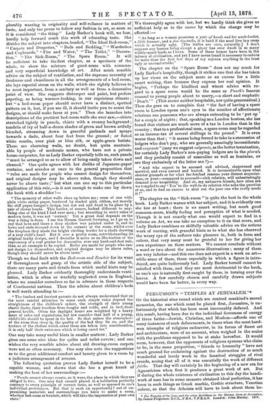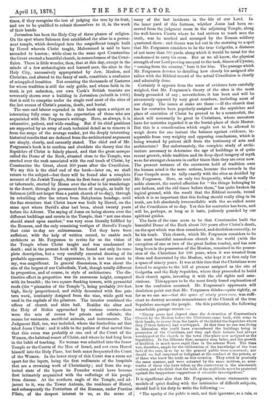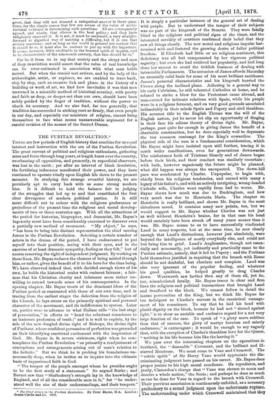FERGUSSON'S "TEMPLES AT JERUSALEM."*
OF the historical sites round which are centred mankind's sacred memories, the one which must be placed first, Jerusalem, is un- fortunately that which has been most irrevocably defaced. And this result, having been due to the individual fierceness of energy of three faiths—Jewish, Christian, and Moslem—affords one of many instances of such defacements, in times when the most hard- won triumphs of religious endeavour, in its forms of finest art and architecture, were of no account, when weighed in the scales with the problems supposed to be at stake hereafter. It would seem, however, that the opponents of religious systems who claim to be, in the same proportion, "friends to humanity " have not much ground for exclaiming against the destruction of so much wonderful and lovely work in the fanatical struggles of rival creeds, seeing that all of it was essentially the work of different faiths. That day will certainly be the beginning of a new era for Agnosticism when first it produces a great work of art. But if during the whole existence of civilisation to this day the handi- work of man has in some measure obtained ideal perfection, it has been in such things as Greek marble, Gothic structure, Venetian colour, so that the Atheists will have to look about them be-
• The Temples of the Jews, and the other Buildings in the Harem Area at Jerusalem. By James Fergasson, D.C.L., V.P.B.A.S. London: John Murray. 1878.
times, if they recognise the test of judging the tree by its fruit, and are to be qualified to submit themselves to it, in the work of their hands.
Jerusalem has been the Holy City of three phases of religion. On the spot where Solomon first established the altar in a perma- nent temple, which developed into the magnificent temple built by Herod wherein Christ taught, Mahommed is said to have ascended to heaven ; while close to the same spot Constantine the Great erected a beautiful church, in remembrance of the Cruci- fixion. There is little wonder, then, that at this day, except in the minds of a few archaeologists and learned men, the sites in the Holy City, successively appropriated by Jew, Moslem, and Christian, and altered to the fancy of each, constitute a confusion of misapplied localities. Not counting the thousands of Easterns for whom tradition is still the only guide, and whose faith in its truth is yet unbroken, our own Cook's British tourists are reverently shown over a building in Jerusalem (rebuilt in 1808) that is said to comprise under its single roof most of the sites of the last scenes of Christ's passion, death, and burial.
The care and labour expended in this book upon a subject so interesting fully come up to the expectation of those who are acquainted with Mr. Fergusson's writings. Here, as always, it is exhaustive, patient, and wide-reading. But if its chief positions are supported by an array of such technical detail as to remove it from the scope of the average reader, yet the deeply interesting historical results that are deduced from the architectural argument are simply, clearly, and earnestly stated. The chief end of Mr. Fergusson's book is to confirm and elucidate the theory that the Sepulchre of Christ is falsely placed, and that the great mosque called the Dome of the Rock, situated close to the Temple, was erected over the rock associated with the real tomb of Christ, by Constantine the Great, about 300 years after the Crucifixion. We say this is the chief end of the book—later on, we shall return to the subject—but there will be found also a complete account of the Jewish Temple, from its first form of portable tent or tabernacle, erected by Moses over the altar in his wanderings in the desert, through its permanent form of temple, as built by Solomon (still not larger than a parish church of to-day), through its rebuilding after the return from Babylonian bondage, until the fine structure that Christ knew was built by Herod, on the same spot where David's altar had been, about twenty years before the Advent. The saying of Jeans on being shown over the different buildings and courts in the Temple, that "not one stone should stand upon another," was very soon literally fulfilled by the Romans, and the only remaining vestiges of Herod's Temple that exist to-day are subterranean. Yet they have been sufficient, with the help of written record, to enable such architects as Mr. Fergusson to revive for us the vision of the Temple where Christ taught and was condemned to death ; and in the present book will be found not only its com- plete description, but a very carefully executed drawing of its probable appearance. That appearance, it is not too much to say, was magnificent. In general dimensions, it was about the size of the largest of our Cathedrals, York, though totally different in proportion, and of course, in style of architecture. The dis- tinctive effect in proportion was its enormous height, compared with its breadth ; the two square flanking towers, with pyramidal roofs (the "pinnacles of the Temple "), being probably 200 feet high, finely proportioned, and richly decorated with fine pat- tern work, intricately designed from the vine, while gold was used in the capitals of the pilasters. The interior combined the offices of church and shire hall. Besides the altar and the Holy of Holies approached by various courts—there were the sets of rooms for priests and officials, the rooms for vestments, sacrificial animals, and instruments. The Judgment Hall, too, was included, where the Sanhedritn sat that tried Jesus Christ ; and it adds to the pathos of that sacred time that this room was probably at one end of the Court of the Women, the habitual resort of Christ, and where he had long been in the habit of teaching. No woman was admitted into the Inner Temple or the Courts of the Men of Israel, and not even Herod himself into the Holy Place, but both sexes frequented the Court of the Women. In the lower story of this Court was a room set apart for the lepers, being the first rudiments of the hospitals that are a crowning work of Christianity ; and from the neg- lected state of the lepers its Founder would have become first intimately acquainted with the sufferings of his people from disease. At the northern angle of the Temple, and ad- jacent to it, was the Tower Antonia, the residence of Herod, and subsequently the Prmtorium of the Romans, under Pontius Pilate, of the deepest interest to us, as the scene of many of the last incidents in the life of our Lord. In the inner yard of this fortress, whither Jesus had been re- moved from the judgment room in the adjoining Temple, along the well-known Courts where he had striven to teach men the truth, was he mocked and scourged by the Roman soldiery quartered there ; and thence was led out in the morning to a spot that Mr. Fergusson considers to be the true Golgotha, a distance of not more than 300 yards, along which it would be usual for the condemned to carry his cross. But as we all know, the physical strength of our Lord proving unequal to the task, Simon of Cyrene, "coming from the country," bore it for him. The passage which Mr. Fergusson devotes to detailing how closely his assigned site tallies with the Biblical record of the actual Crucifixion is clearly and admirably done.
Certainly it appears from the mass of evidence hero carefully weighed, that Mr. Fergusson's theory of the sites is the most firmly grounded of any ; nevertheless, it has been and will be strenuously opposed by very great numbers, including most of our clergy. The issues at stake are these :—If the church that has for centuries been popularly assigned as the sepulchre and place of execution of Christ be proved to be a counterfeit, the shock will necessarily be great to Christians, whose ancestors have for centuries regarded it as the burial-place of their Master. But this is a consideration which ought not to be allowed to weigh down for one instant the balance against evidence, in- separable from very weighty and opposing conclusions, which is being wrested by patient skill from the testimony of arts and architecture? But unfortunately, the complete study of archi- tecture necessary to determine the age of buildings is of quite recent growth, while tradition and its deep-dyed imagery of myth were far stronger elements in earlier times than they are even now. The present instance of the enormous hold of tradition over the human mind is the more serious, because the records in the Four Gospels seem to tally exactly with the sites as decided by Mr. Fergusson. Here, as only too frequently, what is really the noble element, the rooted affection for "the things belonging to our fathers, and the old times before them," has quite broken its logical ground, with the result that the Biblical records, round which it is so important that this feeling should really cling in its truth, are left absolutely irreconcilable with the so-called scene of the Crucifixion of to-day. Yet this for centuries has been, and will be, perhaps, as long as it lasts, jealously guarded by our spiritual guides.
The facts of the case seem to be that Constantine built the beautiful Dome of the Rock about 300 years after Christ's death, on the spot which was then considered, and doubtless correctly, to be his tomb. This church, which Mr. Fergusson considers to be the most beautiful mausoleum church in the world (with the exception of one or two of the great Indian tombs), and has now long been in the possession of the Moslem, remained in the posses- sion of the Christians for 686 years, when it was wrested from them and desecrated by the Moslem, who kept it at first only for a space of ninety years. It was at this time that the Christians were forced to migrate to the bill at present assigned as the site of Golgotha and the Holy Sepulchre, where they proceeded to build
their church again, investing it with the old rights and asso- ciations. This appears to be the most firmly based explanation of how the confusion occurred. Mr. Fergusson's opponents will doubtless point out that Mr. Fergusson thinks—quite rightly, as far as we can see—that this space of ninety years even, was suffi-
cient to destroy accurate remembrance of the Church of the true Sepulchre amongst the people. On this particular, the following remarkable passage occurs :—
"Ninety years had elapsed since the destruction of Constantine's Church by tho Moslem before the Christians came back, with arms in their hands, to rescue from the hands of the Infidel the Sepulchre where they [? their fathers] had worshipped. At that time no one was living in Jerusalem who could have remembered the buildings being in possession of the Christians, and they and their fathers had always worshipped at the church in the town (the place now assigned as the Sepulchre). In the illiterate East, memory soon fades, and the growth of tradition is much more rapid than in the soberer West. The time was, therefore, ample for the obliteration of the knowledge of the true facts of the case, in so far as the general public were concerned ; nor should we feel surprised or indignant at the conduct of the priests, or of those who knew the truth on this occasion. They acted in precisely the same manner' and were actuated by the same motives, as nine- tenths of those who have taken up the controversy in the nineteenth century, and who think that the faith of the multitude must be protected against the Inopportune suggestions of scientific investigations."
It is significant also that Mr. Fergusson, whose statements are models of quiet dealing with the intricacies of difficult subjects, should feel it his duty to write the following :—
" The apathy of the public is such, and their ignorance, as a rule, 50
great, that they will not demand a categorical answer to these ques- tions, for the simple reason that few are aware of the value of archi- tectural evidence in determining such questions. All are consequently agreed, and wisely. that silence is the best policy ; and they have i religiously observed it. It is not, t must be confessed, a very straight- forward or dignified way of meeting a difficulty, but it is one that society sanctions; and as long as the world in general are content that It should be so, it must also be content to put up with tho imposture. It seems, however, little creditable to the boasted spirit of inquiry, said to ho characteristic of the nineteenth century, that this should be so."
Far be it from us to say that society and the clergy and men of deep conviction would assert that the value of real knowledge can be over-estimated in association with what man holds sacred. But when the crucial test arrives, and by the help of the archmologist, artist, or explorer, we are enabled to trace back, step by step, each su ccessive link and phase in the history of a building or work of art, we find how inevitable it was that men unversed in a scientific method of historical scrutiny, with poetry and faith as deep, or deeper-set than our own, should have been solely guided by the finger of tradition, without the power to check its accuracy. And we also find, far too generally, that tradition has succeeded in striking root so firmly, that even people in our day, and especially our ministers of religion, cannot bring themselves to face what seems unanswerable argument for a careful revision of the scenes of the Sacred Drama.




































 Previous page
Previous page